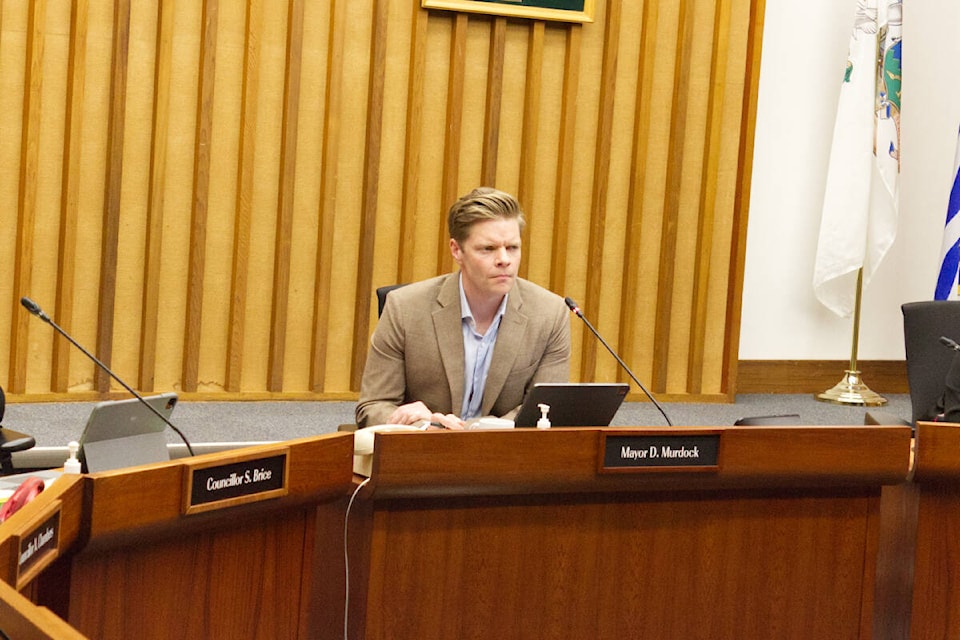Saanich council approved the district’s new Official Community Plan (OCP) bylaw on May 7, remaking the foundational land use document that guides local development.
As expected, council removed Local Area Plans (LAPs) from the OCP and adopted these separately through council resolution, meaning they now have less force and can be overruled by the OCP.
“This finishes off the trajectory that we were on, which is to have a standalone Official Community Plan bylaw,” Coun. Zac de Vries said.
The bylaw was adopted at the continuation of a public hearing that began on April 30. That hearing had to be extended after public comment stretched on for almost six hours.
Many of the people who showed up to speak on April 30 were upset about the removal of the LAPs from the OCP, as well as other changes meant to spur housing development.
The LAPs are smaller neighbourhood level planning documents that cover some of the same issues as the district-wide OCP.
Mayor Dean Murdock began the continuation of the public hearing by asking a series of questions to district planning staff to try to clarify the rationale behind some of these decisions and settle some of the issues raised on April 30.
These questions ranged from what role provincial legislation had in the OCP’s creation and whether these new provincial rules actually mean no more public hearings for development, to what the rationale was for removing the LAPs and how that will impact decision-making.
Murdock did note that it was the direction of council to remove the LAPs, but he still asked for staff to summarize the reasons why.
Cameron Scott, the district’s manager of community planning, answered most of the questions.
On the LAPs, he gave a number of reasons for the change, including that the decision to focus resources into Centre, Corridor and Village plans instead of LAPs means the LAPs would not be updated for the foreseeable future, and most of them are already 15-to-25 years old.
This upped the chance of inconsistencies between the OCP and LAPs, especially considering new parts of the OCP framework such as active transportation plans and climate plans that did not exist 20-plus years ago.
“The planning context today is quite different,” Scott said.
This doesn’t mean the LAPs won’t be consulted in planning decisions, he added, simply that if there is a conflict between the LAPs and the OCP, that the OCP wins out.
“It will be looked at holistically,” Scott said of planning decisions. “But in areas where there was direct conflict, the OCP would be the primary document that would be given greater importance in the hierarchy of decision-making.”
Scott said the new provincial legislation did factor somewhat into this OCP, but that those effects were minor.
“Our OCP previously did permit a variety of housing in neighbourhoods,” Scott said. “The transit-oriented areas required some minor adjustments to some of our land use designations in the Uptown, Royal Oak and university area, but largely the provincial announcements did not dramatically impact the shape and the growth management structure of the OCP.”
The new provincial rules aimed at encouraging housing development did alter the ability of districts to hold public hearings. This was something that seemed to have generated quite a bit of uproar at the April 30 hearing.
Lindsay Chase, Saanich’s planning director, stepped in to answer this one. She said it is true there will be no more public hearings for residential development, but that does not mean no public hearings at all.
Public hearings will still be required to change or amend the OCP, as well as for any commercial or industrial developments.
“I heard at the public hearing that this is the last public hearing, and I would I would like to refute that,” she said. “That is that is not actually the case.”
Those rules are also provincial, and Saanich must abide by them regardless of whether council adopts this version of the OCP.
In an unusual move, Coun. Colin Plant, also the director of the Capital Regional District, said he had not seen it done before — council gave third and final reading of the OCP motion in the same meeting, cementing it into law without having to revisit it again.
Coun. Nathalie Chambers and Coun. Judy Brownoff were the only two to vote against against adopting the OCP.
READ MORE: Saanich OCP hearing brings concerned crowds to council
